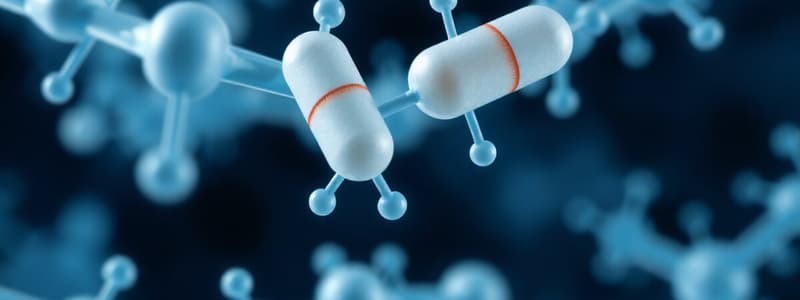Podcast
Questions and Answers
What is one possible outcome of increasing the dose after reaching maximal efficacy?
What is one possible outcome of increasing the dose after reaching maximal efficacy?
- The side effects will become less severe.
- The response will increase significantly.
- The response will remain the same. (correct)
- The body will adapt to the increased dosage.
What may occur if a dose is increased beyond the maximal efficacy?
What may occur if a dose is increased beyond the maximal efficacy?
- Enhanced therapeutic effects.
- Improved cellular response.
- Increased risk of toxicity. (correct)
- Decreased likelihood of side effects.
Increasing the dose after maximal efficacy is reached could result in which of the following?
Increasing the dose after maximal efficacy is reached could result in which of the following?
- Increased absorption of the drug.
- Immediate withdrawal symptoms.
- Heightened immune response.
- Cellular exhaustion. (correct)
When maximal efficacy has been achieved, what happens to the effectiveness of subsequent doses?
When maximal efficacy has been achieved, what happens to the effectiveness of subsequent doses?
What should be avoided to ensure optimal study conditions after reaching maximal efficacy?
What should be avoided to ensure optimal study conditions after reaching maximal efficacy?
What is a common consequence of increasing the dose of a drug?
What is a common consequence of increasing the dose of a drug?
What is true about drug specificity?
What is true about drug specificity?
What is the relationship between side effects and adverse effects?
What is the relationship between side effects and adverse effects?
What term is used to describe the effects of a drug that are not its principal target?
What term is used to describe the effects of a drug that are not its principal target?
How do side effects arise when using medications?
How do side effects arise when using medications?
What does a higher association constant (Ka) generally indicate about a ligand's affinity for a receptor?
What does a higher association constant (Ka) generally indicate about a ligand's affinity for a receptor?
What is the significance of the dissociation constant (Kd) in receptor-ligand interactions?
What is the significance of the dissociation constant (Kd) in receptor-ligand interactions?
If a drug has an association constant of 140, what can be inferred about the ligand-gated ion channel?
If a drug has an association constant of 140, what can be inferred about the ligand-gated ion channel?
In ligand-gated ion channels, how is the α parameter related to the drug's association and dissociation constants?
In ligand-gated ion channels, how is the α parameter related to the drug's association and dissociation constants?
What would a very high Kd value imply about the ligand-gated ion channel's functionality?
What would a very high Kd value imply about the ligand-gated ion channel's functionality?
What should be done if a patient does not respond to the initial medication dose?
What should be done if a patient does not respond to the initial medication dose?
What is indicated if a patient still does not respond after reaching the drug's maximum efficacy?
What is indicated if a patient still does not respond after reaching the drug's maximum efficacy?
What is the role of E-max in medication administration?
What is the role of E-max in medication administration?
If a patient is unresponsive to treatment, what is NOT an appropriate action?
If a patient is unresponsive to treatment, what is NOT an appropriate action?
Which statement about adjusting medication dosage is FALSE?
Which statement about adjusting medication dosage is FALSE?
What does a higher curve indicate regarding the efficacy of a drug?
What does a higher curve indicate regarding the efficacy of a drug?
How can the efficacy of a drug be assessed?
How can the efficacy of a drug be assessed?
If a drug's efficacy curve is low, what can be inferred about the drug?
If a drug's efficacy curve is low, what can be inferred about the drug?
Why is it important to evaluate the height of the efficacy curve?
Why is it important to evaluate the height of the efficacy curve?
In the context of drug efficacy, what does a lower curve compared to a higher one suggest?
In the context of drug efficacy, what does a lower curve compared to a higher one suggest?
What does the ED50 represent in pharmacology?
What does the ED50 represent in pharmacology?
How is the therapeutic index calculated?
How is the therapeutic index calculated?
If Drug 1 has a therapeutic index of 10 and Drug 2 has a therapeutic index of 5, which drug has a wider safety margin?
If Drug 1 has a therapeutic index of 10 and Drug 2 has a therapeutic index of 5, which drug has a wider safety margin?
Which of the following statements is true regarding LD50 and ED50?
Which of the following statements is true regarding LD50 and ED50?
What can be inferred about Drug 1 and Drug 2 if they have the same ED50 but different LD50 values?
What can be inferred about Drug 1 and Drug 2 if they have the same ED50 but different LD50 values?
Flashcards
Drug side effects
Drug side effects
Unintended effects of a drug targeting proteins other than the intended one.
Drug specificity
Drug specificity
The ability of a drug to target only the desired protein.
Adverse effects
Adverse effects
Unwanted and potentially harmful effects of a drug.
Side effects (vs. adverse effects)
Side effects (vs. adverse effects)
Signup and view all the flashcards
Association Constant (Ka)
Association Constant (Ka)
Signup and view all the flashcards
Dissociation Constant (Kd)
Dissociation Constant (Kd)
Signup and view all the flashcards
Ligand-Gated Ion Channel
Ligand-Gated Ion Channel
Signup and view all the flashcards
Number of α subunits in Ligand-Gated Ion Channel?
Number of α subunits in Ligand-Gated Ion Channel?
Signup and view all the flashcards
Drug Efficacy
Drug Efficacy
Signup and view all the flashcards
Higher Curve
Higher Curve
Signup and view all the flashcards
Lower Curve
Lower Curve
Signup and view all the flashcards
Maximizing Drug Efficacy
Maximizing Drug Efficacy
Signup and view all the flashcards
Drug Ineffectiveness
Drug Ineffectiveness
Signup and view all the flashcards
Switching Drugs
Switching Drugs
Signup and view all the flashcards
Maximal efficacy
Maximal efficacy
Signup and view all the flashcards
Dose increase beyond maximal efficacy
Dose increase beyond maximal efficacy
Signup and view all the flashcards
Side effects/Toxicity
Side effects/Toxicity
Signup and view all the flashcards
Effect decrease after maximal efficacy
Effect decrease after maximal efficacy
Signup and view all the flashcards
Therapeutic Index
Therapeutic Index
Signup and view all the flashcards
ED50
ED50
Signup and view all the flashcards
LD50
LD50
Signup and view all the flashcards
Drug Safety
Drug Safety
Signup and view all the flashcards
Study Notes
Pharmacodynamics 1 Lecture Notes
- Pharmacodynamics is the study of what a drug does to the body.
- It describes the pharmacological actions of a drug.
- The effect of the drug on the human body is called pharmacodynamics
- The effect of the human body on a drug is called pharmacokinetics.
- Drugs modify existing functions, possibly increasing or decreasing them.
- Drugs must target specific sites within cells to work.
- Drug targets are proteins, including enzymes, carrier proteins, ion channels, and receptors.
- Ligand specificity is important for drug action; drugs bind to specific molecules in cells with high precision.
- Drugs are not completely specific in their actions. Increasing the dose might affect unintended targets, leading to side effects.
- Side effects are unavoidable, especially with higher doses.
- There are two main types of drug interactions:
- Agonists: bind and activate receptors (may be full or partial).
- Antagonists: bind to receptors but do not activate them (zero efficacy).
- Affinity is the ability of a drug to bind to a receptor.
- Efficacy is the ability of the drug-receptor complex to produce a cellular response.
- A dose-response curve shows the relationship between drug dose and response.
- The curve rises until maximum efficacy is reached
- Threshold dose: the dose below which no effect is observed
- Efficacy is assessed by measuring the height of the dose-response curve
- Potency is determined by the dose needed to achieve a specific effect (often 50% of maximum effect, ED50).
- A higher potency means a lower dose is needed.
- Therapeutic index is the ratio of the lethal dose (LD50) to the effective dose (ED50) for a drug. A higher therapeutic index indicates a safer drug.
- Competitive antagonists shift the agonist's dose-response curve to the right without decreasing maximal response.
- Irreversible antagonists shift the curve both to the right and down, decreasing maximal efficacy.
- Drug action refers to the initial molecular events after drug binding.
- Drug effects refer to the observable changes in physiological function.
- Drug actions cannot be measured, whereas effects can be observed and measured.
- A drug can have affinity but not efficacy.
Quiz Questions
- A drug has a Ka of 140 and a Kd of 2. Calculate its affinity.
- How many alpha subunits are present in ligand-gated ion channels?
Studying That Suits You
Use AI to generate personalized quizzes and flashcards to suit your learning preferences.




